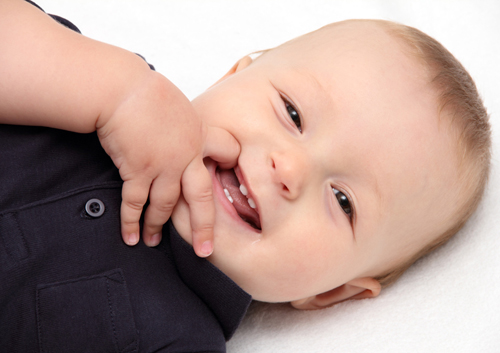How to Care for a Teething Baby
December 24th, 2025

After hours of juggling a wailing baby, you’re probably desperate to address teething pain. If your baby is irritable, drooling, and chewing on hard objects, he or she is likely teething. Although some discomfort while your baby is teething is inevitable, learning a few basic approaches can ease painful gums and soothe your frazzled nerves.
- Offer your finger. Simply chewing on your nice, plump finger may be enough to ease your little one’s pain. Make sure you clean your finger before placing it in your baby’s mouth.
- Use a teething ring. A firm rubber teething ring allows your child to gnaw, and alleviates pain. If your baby seems to like sucking on a bottle, replace the milk or formula with water during teething periods. This reduces sugar intake and decreases the risk of tooth decay.
- Cool it down. Stick a clean, moist washcloth in the freezer (place it on a tray for cleanliness) and offer that to your baby. The cooler temperature of the chilled cloth eases the pain of teeth erupting through the gums. Soaking the washcloth in non-caffeinated tea, such as chamomile, may reduce inflammation associated with teething.
- Grab some hard foods. Certain foods allow your kiddo to gnaw, and can ease teething pain. For example, frozen bananas, large chunks of chilled carrots, an apple, or frozen bagels make good teething pain relievers. If you’re offering your child solid food, watch carefully to ensure that your infant doesn’t bite off a piece and choke.
- Try a natural remedy. Years of grandmotherly wisdom suggest that home remedies might help with teething. Try rubbing clove oil, peeled ginger root, or vanilla extract onto your child’s gums. Although there isn’t scientific evidence to prove these remedies are effective, they may help your little one through the painful teething process. Just remember to test the method out on your own gums first to ensure any tingling or numbing is bearable for your child.
- Use medications. If your baby seems to be especially uncomfortable, over-the-counter medications may be appropriate. Giving an age-appropriate dose of acetaminophen (Tylenol) or ibuprofen (Advil) may reduce discomfort. Make sure you check with your child’s pediatrician or our office first to ensure the medication is safe.
If nothing seems to be helping your child’s teething pain, you can always schedule an appointment with Drs. Rottschalk, Acker, and Froidcoeur. Our team at Dr. John Rottschalk Dental Group understands the unique health needs of your little one, and are more than happy to help ensure he or she grows up with a beautiful smile.
For more information about teething, or to schedule an appointment with Drs. Rottschalk, Acker, and Froidcoeur, please give us a call at our convenient Fairview Heights, IL office today!
Getting to the Bottom of Chewing Gum Myths
December 17th, 2025

It's a moment many of our patients have experienced. One second you're chewing on a piece of gum, then suddenly you forget to keep chewing and swallow the entire rubbery gob whole! It's at this point you remember your mother warning you as a child that if you swallow gum it will stake a claim and take up residency in your belly for seven years. Drs. Rottschalk, Acker, and Froidcoeur and our team at Dr. John Rottschalk Dental Group hate to take all the fun out of the mystery, but the truth is that chewing gum, when swallowed, will enter your stomach and move through your digestive system just like any other piece of food. So, if you ever accidentally swallow a piece of gum, there is no need to worry!
That being said, it's important to know that gum does not have any dietary benefits, so while it’s not exactly harmful to swallow, you still want to avoid swallowing it. If you are an avid gum-chewer, we encourage you to chew sugarless gum, especially if you are wearing braces, because gum with sugar can lead to cavities. Sugarless gum still has the same amount of flavor, but has fewer cavity-causing ingredients. In fact, many brands contain an additive called xylitol, a natural sweetener known to fight cavity-causing bacteria. Xylitol is also known to increase salivary flow as it rinses away plaque and acid.
The fact is, when the bacterium in your mouth breaks down sugar, what’s left behind is acid. This acid eats away at the enamel coating of your teeth, causing holes that we call cavities. Cavities can lead to other long-term mouth problems if they are not treated in time, so it is best to try and avoid overexposing your teeth to too many harmful substances!
If you have any questions about chewing gum, please contact our office. Happy (sugar-free) gum chewing!
Sleep Apnea and Snoring
December 10th, 2025

Snoring may not be something you take seriously. You might even laugh or joke about it. But the fact is, anytime you or your partner snore to the point of waking, it could be a sign of serious health problems.
Sleep Apnea and Its Effects
Sleep apnea is a sleep disorder that is potentially dangerous, and the most common symptom is loud snoring. Breathing repeatedly starts and stops throughout the night, and you wake up feeling tired. Other serious effects from sleep apnea could be potentially dangerous to your health if left unaddressed.
Besides losing a good night's sleep, you may experience difficulty concentrating. Depression, risk of heart attack, irritability, high blood pressure, memory loss, sexual dysfunction, and chances of stroke all increase when sleep apnea is not treated.
Sleep apnea occurs when the muscles in the back of the throat relax to the point of inhibiting natural breathing. The muscles used to support the soft palate relax and the airway closes, causing breathing to stop for ten to 20 seconds. This lowers the oxygen level in the brain. As the brain senses the inhibited oxygen levels it rouses the sleeper awake so the airway can reopen. Normally, the reawakening is so brief the person won't remember it.
If you think you may have sleep apnea, visit our Fairview Heights, IL office and let Drs. Rottschalk, Acker, and Froidcoeur determine what treatment is needed. Without it, you could risk losing more than a restful night's sleep.
Prevention and Treatment
Anyone can develop sleep apnea, but it is more common among middle-aged adults who are overweight. Drs. Rottschalk, Acker, and Froidcoeur can help you determine the cause and suggest positive treatment.
A common treatment for apnea is the placement of oral devices that are designed to help keep the airway open. By bringing the jaw forward, the device opens the airway and thereby discourages snoring. We are experienced in sleep apnea appliances, and Drs. Rottschalk, Acker, and Froidcoeur can prescribe a fitted device and monitor its success with follow-up therapy.
A continuous positive airway pressure mask, known as a CPAP, is among the other treatment options. A mask is fitted over the mouth and forces oxygen through the throat while you sleep. The pressure holds the soft tissue and throat muscles open.
Our professionals at Dr. John Rottschalk Dental Group can advise you of other ways to prevent sleep apnea, including weight loss, avoiding alcohol, or alternative sleeping positions. We can help you sleep return to easy sleep, knowing you are safer and healthier during your resting hours.
Holiday Gift Ideas for Healthy Holiday Smiles
December 3rd, 2025

Need some gift ideas for family members and friends who seem to have absolutely everything? Who are impossible to shop for? Who tell you not to worry, it’s the thought that counts? Well, we have a few suggestions which will show the people on your gift list that you’ve put a lot of thought into their gifts this holiday season.
You love to see your friends and family smile, so we’ve come up with some smile-worthy ideas designed for their specific interests.
Environmental Ally
The world is becoming a more eco-conscious place, and happily this transformation includes products designed for personal care. Put together a spa basket which is good for your friend’s comfort, dental health, and the planet!
A recycled gift box filled with environmentally friendly bath products and organic cotton face cloths becomes even more mindful with the addition of bamboo or recycled plastic toothbrushes, zero-waste fluoride toothpaste tablets, and biodegradable picks and floss.
Don’t forget to include a colorful, insulated water bottle for sustainable hydration—and washing away food particles when there’s no handy place to brush after eating. Healthy planet/healthy smile.
Talented Techie
If your friend or relative is cutting edge high-tech, maybe it’s time for a dental upgrade.
Modern electric toothbrushes offer plenty of options for the tech-savvy. They come with different settings for brushing and massaging. They can let brushers know if they’ve brushed long enough, if they’re brushing too hard, or when the brush head needs to be retired. Smart models even link to apps, which can, among other things, map out any missed spots in brushing coverage or suggest more effective brushing angles.
And for an extra thoughtful touch, include a packet of plaque disclosing tablets. Chew one of these helpful little tablets and they will reveal any plaque that’s still on the teeth.
Adventure Seeker
How about a new backpack or carry-all for outdoor or travel adventures? A travel first aid kit is always a welcome addition for the person on the go.
Go the extra step and help a friend be prepared for anything with an emergency dental kit. You can find these lightweight kits in stores or online, or you can assemble one yourself with a travel-size toothbrush and toothpaste, floss, a travel mirror, cotton rolls, pain relievers, and even temporary fillings. Include a pack of sugar-free gum—it helps with altitude changes and hydration. Ask Drs. Rottschalk, Acker, and Froidcoeur or the team at Dr. John Rottschalk Dental Group for suggestions!
Timeless Trendsetter
Older relatives might love a selection of modern gifts designed with old-fashioned comfort in mind, such as an automatic jar opener and a selection of jams, trekking poles for easier hiking, or wireless earbuds for enjoying music or an audio book.
For a lifetime of healthy smiles, consider adding a water flosser to your gift basket. Gum disease is a leading cause of tooth loss for older Americans. Water flossers are a great way to eliminate stubborn plaque, especially when mobility issues make manual flossing difficult. Adjustable water pressure applies just the right amount of cleaning power, and the flow can be directed to the gumline, between teeth, or anywhere necessary.
Film Buff
If your bestie likes nothing better than an evening spent in front of the home screen, consider a subscription or gift card for a streaming service tailored to his or her favorites, whether it’s classic films, sci-fi, action, rom-coms, or epic adventures.
And don’t forget the binge-watch treats! Fill a basket with dental-friendly goodies like fresh fruits, nuts, and dark chocolate. Include a collection of simple sparkling waters or a gift card for vitamin-rich smoothies. Who needs sugary candies and sodas with options like these?
No matter who’s on your shopping list, tailoring your gifts to their interests and their well-being is a great way to share happy, healthy holiday smiles with family and friends in Fairview Heights, IL.





